

Seth’s blog » Blog Archive » Exploratory Versus Confirmatory Data Analysis? In 1977, John Tukey published a book called Exploratory Data Analysis.

It introduced many new ways of analyzing data, all relatively simple. The Archaeology of the Mediterranean World: Archaeology. Over the next two months, I've been asked to write an essay on settlement in 7th and 8th century Cyprus. My work at Polis-Chrysochous and at the site of Pyla-Koutsopetria puts me in a good position to think broadly of this transitional period with two specific points of reference. The coastal site of Pyla-Koutsopetria appears to go into steep decline after the middle of the 7th century coinciding, it would seem, increased activity of the Arab fleet in middle decades of the 7th. During the 5th-7th century, there is every indication that the site was prosperous coastal emporium. The almost complete absence of material dating to the 8th or 9th centuries would seem to indicate that the site no long constituted a substantial locus of settlement on the south coast of the island.
Polis-Chrysochous, or ancient Arsinoe, appears to have had a different history. Classifying an Archaeologist : Aardvarchaeology. Carl Lipo at Evolution Beach has been kind enough to recommend Aard to his readers.
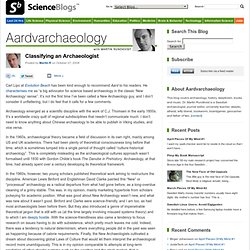
He characterises me as “a big advocator for science based archaeology in the classic ‘New Archaeology’ sense”. It’s not the first time I’ve been called a New Archaeology guy, and I don’t consider it unflattering, but I do feel that it calls for a few comments. Archaeology emerged as a scientific discipline with the work of C.J. Thomsen in the early 1800s. It’s a worldwide crazy quilt of regional subdisciplines that needn’t communicate much. In the 1960s, archaeological theory became a field of discussion in its own right, mainly among US and UK academics. A Sceptical Archaeology. Bad Archaeology: leave your common sense behind! American Antiquity, Vol. 43, No. 2 (Apr., 1978), pp. 231-244. The Statistics Lesson: Archaeology and Statistics. "I just don't get statistics," Katie said plaintively.
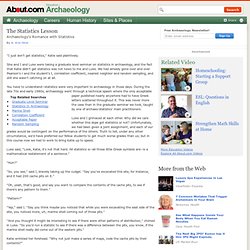
She and I and Luke were taking a graduate level seminar on statistics in archaeology, and the fact that Katie didn't get statistics was not news to me and Luke. We had already gone over and over Pearson's r and the student's t, correlation coefficient, nearest neighbor and random sampling, and still she wasn't catching on at all. You have to understand--statistics were very important to archaeology in those days. During the late 70s and early 1980s, archaeology went through a technical spasm where the only acceptable paper published nearly anywhere had to have Greek letters scattered throughout it.
Open Archaeology. Computational archaeology. Computational archaeology describes computer-based analytical methods for the study of long-term human behaviour and behavioural evolution.
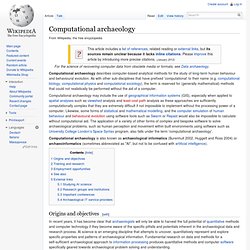
As with other sub-disciplines that have prefixed 'computational' to their name (e.g. computational biology, computational physics and computational sociology), the term is reserved for (generally mathematical) methods that could not realistically be performed without the aid of a computer. Computational archaeology is also known as archaeological informatics (Burenhult 2002, Huggett and Ross 2004) or archaeoinformatics (sometimes abbreviated as "AI", but not to be confused with artificial intelligence). Origins and objectives[edit] In recent years, it has become clear that archaeologists will only be able to harvest the full potential of quantitative methods and computer technology if they become aware of the specific pitfalls and potentials inherent in the archaeological data and research process.
Training and research[edit] See also[edit] Statistics for Archaeologists: A Common Sense Approach Interdisciplinary Contributions to Archaeology: Amazon.co.uk: Robert D. Drennan. Review Praise for the 2nd Edition: "Statistics is often perceived as something mysterious and hostile, and this holds particularly true for archaeologists...

The merit of Drennan's work is that he takes readers by the hand and gently guides them through that minefield, etting them discover that statistics can be a matter easily approached and understood from a commonsense perspective...Fourteen years after the first edition, a number of important new topics are added. They provide the reader with useful tools to explore archaeological data as the data becomes progressively multivariate...Each section uses the same case study and data set, thus enhancing the comparability of this technique...Drennan successfully conveys complex concepts in smple ways...both students and scholars will surely welcome this gentle introduction to statistics, wherein simplicity does not detract from scientific precision". (Gianmarco Alberti, American Journal of Archaeology, 114.4, 2010).
Statistics for Archaeologists: A Common Sense Approach Interdisciplinary Contributions to Archaeology: Amazon.co.uk: Robert D. Drennan. Review.

David Hurst Thomas. David Hurst Thomas is the Curator in the Department of Anthropology at the American Museum of Natural History and an Adjunct Professor at Columbia University and the City University of New York.[1] Career[edit] Thomas was born and raised in California, and after initially wanting to major in pre-med, ended up receiving all of his degrees in anthropology (including a Ph.D. in 1971) from the University of California, Davis[2] instead.

He is one of the founding trustees for the National Museum of the American Indian at the Smithsonian Institution, was elected to the National Academy of Sciences in 1989, and received the Presidential Recognition Award from the Society for American Archaeology. Bayesian Statistics. John Tukey. John Wilder Tukey ForMemRS[1] (/ˈtuːki/;[2] June 16, 1915 – July 26, 2000) was an American mathematician best known for development of the FFT algorithm and box plot.[3] The Tukey range test, the Tukey lambda distribution, the Tukey test of additivity, and the Teichmüller–Tukey lemma all bear his name.
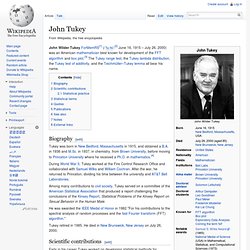
Biography[edit] Tukey was born in New Bedford, Massachusetts in 1915, and obtained a B.A. in 1936 and M.Sc. in 1937, in chemistry, from Brown University, before moving to Princeton University where he received a Ph.D. in mathematics.[4] During World War II, Tukey worked at the Fire Control Research Office and collaborated with Samuel Wilks and William Cochran. How to look at data: A review of John W. Tukey's Exploratory Data Analysis. Exploratory Data Analysis. The late Prof.

John Tukey had a major impact on statistical data analysis. In his classic book entitled Exploratory Data Analysis, he introduced many techniques for discovering unique features contained in data. STATGRAPHICS Centurion contains several of his procedures, plus other methods designed to help extract information: Exploratory data analysis. In statistics, exploratory data analysis (EDA) is an approach to analyzing data sets to summarize their main characteristics, often with visual methods.
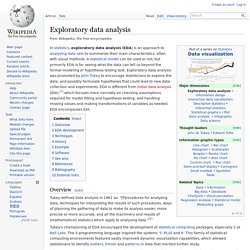
Hoaglin: John W. Tukey and Data Analysis. Seth’s blog » academic fraud.